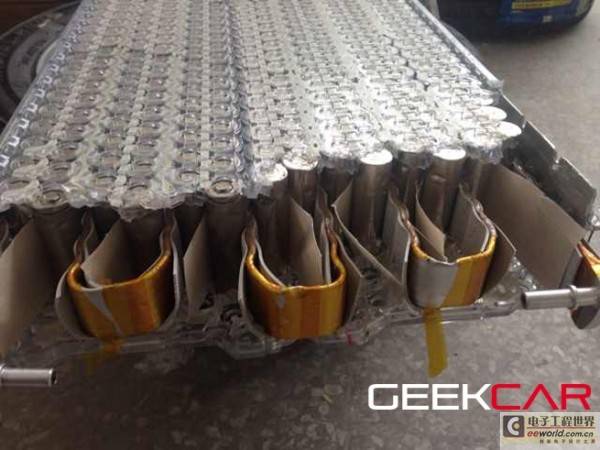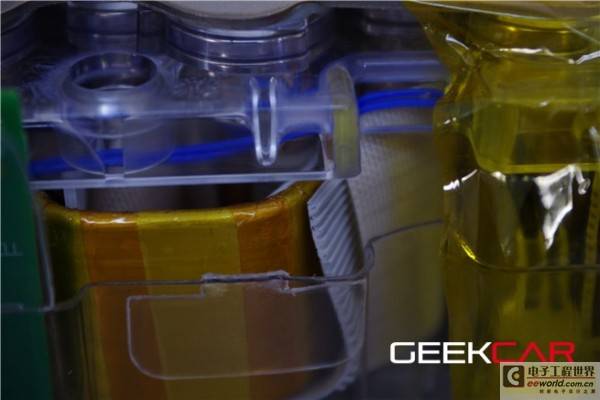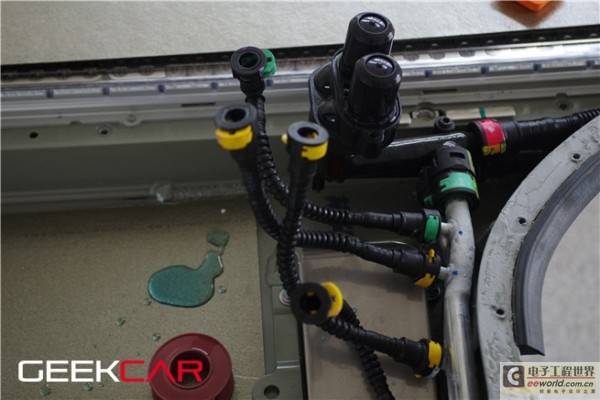Tesla's battery thermal management system
In the news released by major media before, we learned that Tesla has a set of special liquid circulation temperature management system around each single battery, but its specific structure has never been seen. One media reported that "According to the Tesla patent description, the water inside the isolation plate can be static or flowing, and can be directly stored in the internal tube cavity of the isolation plate, or it can be loaded into a specific water bag. If it is in a flowing state, it can be connected to the cooling system of the battery pack, or a self-circulating system can be built."
The model that Youxia Auto disassembled was the Model S 85, which was not equipped with the cold weather package. With the introduction of the engineer, we finally saw the internal structure of Tesla's thermal management system.


(The battery pack casing in the above picture has been violently dismantled by Youxia Automobile, and some batteries have been taken out)
Through violent disassembly, we finally saw the internal structure of the battery pack. Inside the lithium battery pack, the heat-conducting aluminum tube filled with water glycol is surrounded in an S shape. The interfaces on the left and right sides of the picture are the circulation interfaces of the water glycol liquid, and a layer of orange insulating tape is wrapped around the outside of the aluminum tube. In order to prevent the insulating tape from accidentally rupturing, causing the aluminum tube to contact the lithium battery shell and cause a short circuit, Tesla also added a layer of insulating glue to the outside of the aluminum tube for isolation. A layer of insulating glue is also used for isolation between other batteries that do not have aluminum tubes passing through.
When I first saw that Tesla's batteries had so many layers of insulation, I was still very surprised. After thinking for a while, I realized that the 18650 lithium battery used by Tesla is customized. Unlike the lithium batteries we usually see, it has a layer of insulation. The exposed battery shell is the negative electrode of the battery. Once the shell is connected by a conductor, it may cause a short circuit, and in severe cases, it may even cause a fire accident, and the consequences will be disastrous.
Therefore, the multi-layer insulation protection that Tesla has implemented inside the battery pack is still very necessary. Judging from the current design structure, Tesla's protection measures are trustworthy.

(Details of the undisassembled lithium battery pack)
"Coolant" that won't flow?
After disassembling the Tesla, my friends from Youxia Motors told me a very surprising news: the "coolant" in the Tesla's aluminum cooling tube does not flow!
When I heard the news, my first reaction was shock. Tesla went to so much trouble to put the aluminum tube in the middle of the battery, but it just wrapped the battery, and the "coolant" in it didn't flow? Is this the world's most advanced thermal management solution for automotive lithium batteries?
With shock and doubt, I carefully checked every part of the heat dissipation aluminum tube. Unfortunately, I did not find any devices like pumps and temperature control. The "coolant" of Tesla batteries does not flow actively.
The most advanced thermal management solution for automotive lithium batteries in the world placed in front of me really shocked me. But since Tesla did this, there must be a reason for it.

(Lithium battery working liquid interface)
So what exactly is the water glycol "coolant" that wraps around the battery used for?
With doubts, I looked up some relevant information and had a discussion with friends from Youxia Motors. We concluded that "coolant" is used to maintain the temperature consistency of the battery. Due to the dense placement of Tesla batteries, the heat accumulated in the center area is bound to be much greater than that in the periphery. If there is no aluminum tube to transfer heat to maintain the consistency of battery temperature, it will inevitably cause temperature imbalance between each single cell, which will eventually affect the consistency of battery performance and the accuracy of battery state of charge (SOC) estimation, thereby affecting the system control of electric vehicles.
Although Tesla uses 18650 lithium cobalt oxide batteries with extremely high battery consistency, there is even a joke about this type of battery: "If you buy 18650 lithium batteries from the same batch and the instrument detects inconsistent battery performance, you should first suspect that there is something wrong with your instrument?"
However, even if Tesla uses batteries with such high consistency, it cannot guarantee the consistency of the batteries in actual operation. This is because the heat consumption rate (the amount of heat consumed for each 1kW·h of electricity generated) of the battery is different at different temperatures. This is because the chemical reaction inside the battery is closely related to the temperature. If the battery is operated in an internal environment with insufficient heat transfer such as insulation or high temperature, the battery temperature will rise significantly, resulting in the formation of "hot spots" inside the battery pack, which may eventually cause thermal runaway.
Once the battery consistency is problematic, it will have a great impact on the life of the entire battery pack. Therefore, Tesla uses aluminum tubes with high heat transfer efficiency and liquid cooling solutions with high specific heat capacity to maintain the consistency of battery temperature. This is not only for safety reasons, but also crucial to the endurance of electric vehicles.
It is said that the battery thermal management system used by Tesla can control the temperature difference of each single cell in a battery pack within ±2℃. A report in June 2013 showed that after driving 100,000 miles, the battery pack capacity of the Tesla Roadster can still maintain 80%-85% of the initial capacity, and the battery capacity decay is only significantly related to the mileage, and has no obvious relationship with the ambient temperature and the age of the car. It can be seen that Tesla's good control of battery decay is inseparable from the strong support of the battery thermal management system.

(Lithium battery pack working liquid interface and working liquid filling interface)
According to relevant information, the formula of the working liquid in the Tesla aluminum tube is composed of 50% water and 50% ethylene glycol. This is to prevent the working liquid from freezing in low temperature environments. The green liquid flowing out of the pipe in the above picture is Tesla's working liquid.
Does Tesla's "coolant" actually flow?
Tesla's patent states that "the water inside the isolation panel can be static or flowing."
Although the patent was filed a long time ago, there are still some things worth thinking about regarding the circulation of the battery working fluid (coolant). The Model S we have seen uses a passive temperature management system, which is relatively simple and relatively low in cost. Does Tesla also have an active temperature management system? Although this will add some power components, it will make the working fluid in the car flow, and the overall thermal management system will be more effective.
In response to this, our friends at Youxia Automobile have put forward a new guess: if you purchase the cold climate package, will the temperature management module be active?
We speculate that using an active temperature management system, we only need to add a pump and working fluid heating device to the existing battery temperature control module to ensure that the fragile lithium battery can maintain a good operating temperature in extremely cold environments.
But we don't know if this is true. We hope that someone will disassemble the Tesla with the cold weather kit again and reveal to us the battery insulation system of Tesla in extreme cold environments. If the official is willing to disclose its internal structure to us, we are also very willing to report on it in depth.
Previous article:Tesla's Ultimate Teardown: The Tesla Battery Pack Revealed for the First Time (Part 1)
Next article:New energy vehicle battery war: BYD manganese material PK Tesla BMS
- Popular Resources
- Popular amplifiers
- Car key in the left hand, liveness detection radar in the right hand, UWB is imperative for cars!
- After a decade of rapid development, domestic CIS has entered the market
- Aegis Dagger Battery + Thor EM-i Super Hybrid, Geely New Energy has thrown out two "king bombs"
- A brief discussion on functional safety - fault, error, and failure
- In the smart car 2.0 cycle, these core industry chains are facing major opportunities!
- The United States and Japan are developing new batteries. CATL faces challenges? How should China's new energy battery industry respond?
- Murata launches high-precision 6-axis inertial sensor for automobiles
- Ford patents pre-charge alarm to help save costs and respond to emergencies
- New real-time microcontroller system from Texas Instruments enables smarter processing in automotive and industrial applications
- Innolux's intelligent steer-by-wire solution makes cars smarter and safer
- 8051 MCU - Parity Check
- How to efficiently balance the sensitivity of tactile sensing interfaces
- What should I do if the servo motor shakes? What causes the servo motor to shake quickly?
- 【Brushless Motor】Analysis of three-phase BLDC motor and sharing of two popular development boards
- Midea Industrial Technology's subsidiaries Clou Electronics and Hekang New Energy jointly appeared at the Munich Battery Energy Storage Exhibition and Solar Energy Exhibition
- Guoxin Sichen | Application of ferroelectric memory PB85RS2MC in power battery management, with a capacity of 2M
- Analysis of common faults of frequency converter
- In a head-on competition with Qualcomm, what kind of cockpit products has Intel come up with?
- Dalian Rongke's all-vanadium liquid flow battery energy storage equipment industrialization project has entered the sprint stage before production
- Allegro MicroSystems Introduces Advanced Magnetic and Inductive Position Sensing Solutions at Electronica 2024
- Car key in the left hand, liveness detection radar in the right hand, UWB is imperative for cars!
- After a decade of rapid development, domestic CIS has entered the market
- Aegis Dagger Battery + Thor EM-i Super Hybrid, Geely New Energy has thrown out two "king bombs"
- A brief discussion on functional safety - fault, error, and failure
- In the smart car 2.0 cycle, these core industry chains are facing major opportunities!
- The United States and Japan are developing new batteries. CATL faces challenges? How should China's new energy battery industry respond?
- Murata launches high-precision 6-axis inertial sensor for automobiles
- Ford patents pre-charge alarm to help save costs and respond to emergencies
- New real-time microcontroller system from Texas Instruments enables smarter processing in automotive and industrial applications
- The last day of 2018, let’s commemorate
- [Mini intelligent obstacle avoidance mobile robot] Unboxing
- [NXP Rapid IoT Review] + web to get data of rapid iot kit
- [Qinheng RISC-V core CH582] Basic information of the development board, chew slowly and swallow the official library
- 【CH579M-R1】First time rubbing my hands
- The live broadcast has ended [Puyuan Jingdian 2020 New Product Launch and Industry Forum]
- Does the Mars exploration project use domestically produced chips?
- [CH549 Review] Part 1 Hardware Circuit Comparison Analysis
- EEWORLD University Hall----TI FPD-Link III automotive chipset, an ideal solution for automotive video transmission
- Live Broadcast with Prizes | Microchip Security Solutions Seminar Series

 5962-9072301HXA
5962-9072301HXA











 京公网安备 11010802033920号
京公网安备 11010802033920号